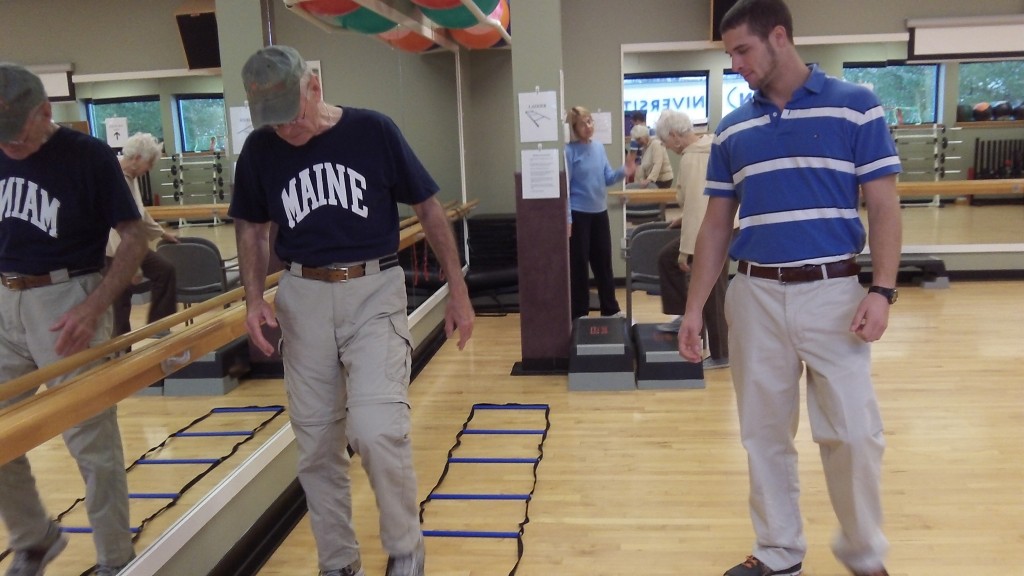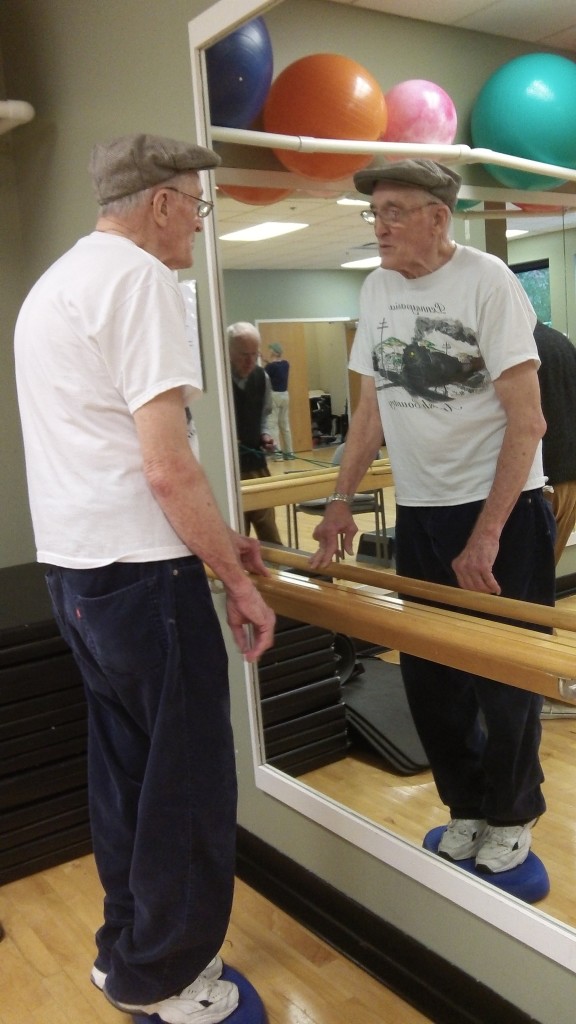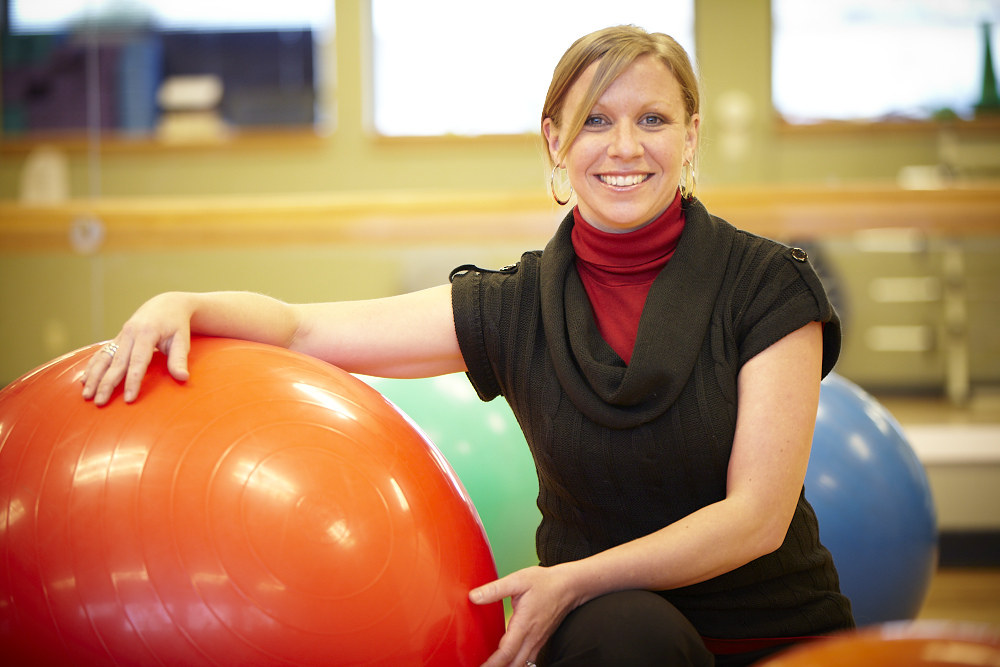If you’re not familiar with Parkinson’s disease, it’s a chronic and progressive movement disorder that affects about one million people in this country. According to the Parkinson’s Disease Foundation, the cause is unknown but involves vital neurons in the brain that no longer function properly or have died. There is no cure right now, but symptoms can be managed with medication and/or surgery.
Parkinson’s disease symptoms
- Tremor of the hands, arms, legs, jaw and face
- Slow movement or bradykinesia
- Rigid, stiff limbs and trunk
- Unstable balance and coordination
Parkinson’s disease exercise program
Since last March, twice a week Conner Moore and Charlie Miller, who both have Parkinson’s disease, having been traveling together from Saco to participate in a Parkinson’s exercise program at the Medically Oriented Gym (the M.O.G.) on Foden Road in South Portland.
The M.O.G., which is affiliated with Saco Bay Physical Therapy, caters to people who need supervised medical support when they exercise. Everyone has an individualized exercise program but generally participates in a small group class. “It might be that they have pulmonary disease, heart disease, cancer, osteoporosis, or are a fall risk,” explains Jaclyn Morrill-Chadbourne, a clinical exercise physiologist and co-owner. “The M.O.G. is for anyone who can’t go to just any facility. We offer specific times when they come in and one of our staff members is dedicated specifically to them and takes them through their individualized exercise program.
Jim Cavanaugh, a professor in the department of physical therapy at the University of New England, approached the M.O.G. about developing the Parkinson’s program that Charlie and Conner attend. It’s designed for people at all levels of the disease and offers a wide variety of activities that focus on balance, flexibility, muscular strength and endurance.
Charlie has had Parkinson’s a lot longer than Conner, so his symptoms are more noticeable. He shuffles when he walks and his arms and hands tremble. “My tremor has really progressed in the last four years,” says. He was diagnosed 15 years ago.
Conner, who is a retired pediatrician, says symptoms differ from person to person. He diagnosed himself in 2010 after noticing that his handwriting was deteriorating. “When I looked at some of my check stubs back to ’07,” he explains, “there was something going on, and then I noticed that I wasn’t moving as fluidly. Little twitches were a red flag too, five years ago.”
He says he’s now moving better and hiking better. “I think my balance is better,” he adds. “I think a lot of the things we do here I can do at home on days I’m not at the gym, such as balancing and stretching. I probably wouldn’t do it as much at home if I weren’t in the program, so I think it’s very helpful and motivating.”
“When I started, I could hardly walk because my balance was so bad,” says Charlie. “I’ve gotten to the point that I’m walking and using the treadmill under supervision at the M.O.G. and I really feel pretty good about it.” He also feels good enough to work on an 18 x 12-foot model train layout — his second. Pretty amazing, considering he’s handling a lot of intricate, miniature structures.
Participating in the Parkinson’s exercise program doesn’t benefit just Charlie and Conner and the other members. They are also participating in an 8-week research project being conducted by the M.O.G. and UNE. The goal is to publish their findings, which already are promising. “Our current data, which is still in the collection phase,” says Jaclyn, “suggests that those individuals participating in a regular exercise program at least 2x/week have little to no progression in their Parkinson’s symptoms over 1 year.”
Removing barriers
Another goal says Jaclyn, is to create a Parkinson’s certification program so that qualified individuals and facilities can provide similar exercise programs in their communities. “We need to remove as many barriers as possible so people are able to do programs such as this,” she says. “Financial barriers, geographical barriers transportation barriers — all of those things, because we know that people get better.”
Unfortunately, participating in a Parkinson’s exercise class isn’t covered by insurance. The Maine Chapter of the American Parkinson’s Disease Association has been able to provide some funding to participants, but M.O.G. intends to continue collecting data over the next five years to “demonstrate to insurance companies that this is a valid and reliable service that warrants reimbursement.”
The M.O.G. is also trying to make the same point to health care providers, employers and individuals. “The moment they get a diagnosis of Parkinson’s disease or heart disease, for instance,” says Jaclyn, ” a lot of people think about what they can no longer do, or how much worse they will be in five to ten years. We’re trying to change that. You don’t have to get worse, you can get better because exercise is such a powerful tool.”








Great post Diane-thanks for helping bring hope to Parkinson’s patients and their families. Do you mind if I re-post this on our blog (with a link back to you as the source)? http://mymogblog.com
Thank you Charity. I’d be delighted if you re-posted it on your blog!
I wish Dr Moore all the best, he’s a great man who helped many during his numerous years of work. I know there are many former patients, current friends and peers especially from the Biddeford/Saco area who are pulling for him!
What a nice thing to say Claire. I’ll make sure that Dr. Moore sees your comment.
[…] The Benefits of Exercise for People with Parkinson’s Disease (dianeatwood.com) […]
[…] Click here to read the full article, written by Diane Atwood (former health reporter for WCSH-TV in Maine) and published on her Catching Health blog. […]
Charlie Miller is my dad and this program has been wonderful for him! I don’t see him as often as I would like being a military wife, but I have noticed how much better he is doing since starting at the M.O.G.! Thank you Diane for sharing this with others who need to know the benefits of exercise.
Emily,
I really enjoyed meeting your dad. He has a great attitude!
My husband has Parkinson’s and since a fall a year ago has great difficulty with balance. He has physical therapy on a regular basis, but exercising regularly at home is a challenge. For the last few months, we have hired someone to come in three times a week to go thru his PT program with him, and the results have been impressive. At this point, it would be wonderful to have a group program that he could participate in – but we live in Central Maine. Any chance of your gym expanding, or partnering with other gyms in Maine?
Hi Polly,
Thanks for asking! It is amazing how beneficial physical activity is proving to be on PD. One of our long-term goals is to expand into other areas and also certify other facilities to provide an evidence-based PD program. With that said, we do not have any immediate plans to expand into Central Maine. However, if there is a particular gym you have in mind, we would be happy to talk about it with them (and you!). Please feel free to email me at charity@mainemog.com and we can talk about it more.
Best,
Charity
As a follow up to this post, I invite you (and your readers) to the M.O.G.’s upcoming Parkinson’s Open House on April 11 to celebrate the birthday of James Parkinson. Open House activities include a Parkinson’s group exercise class demonstration, information on the evidence-based benefits of exercise on Parkinson’s disease and free cupcakes from local bakery Nothing Bakes Like a Parrott. The Open House will be from 9:30-11:30 am on April 11 at the M.O.G. on 29 Foden Road, South Portland. FMI, visit http://mainemog.com/free-parkinsons-open-house-41113/ or email information@mainemog.com or call 207-347-3030.
Hope you can join us!
I am recently retired PT, Dad w/ stage 4 Parkinson’s, just returned home to Me from Fl. Wondering if any one has looked at Rock Steady Boxing program in this area. Would love to learn more about your gym & how it works, different exercise programs…
Tks Kim Secord, PT
Kim, I will look into it for you.
PARKINSONS DISEASE
My husband was diagnosed of Parkinsons disease nearly 7 years ago, when he was 49. He had a stooped posture, tremors, right arm does not move and also a pulsating feeling in his body. He was placed on Senemet for 8 months and then Siferol was introduced and replaced the Senemet, during this time span he was also diagnosed with dementia. He started having hallucinations, lost touch with reality. Suspecting it was the medication I took him off the Siferol (with the doctor’s knowledge) and started him on PD natural herbal formula we ordered from NEWLIFE HERBAL CLINIC, his symptoms totally declined over a 3 weeks use of the Newlife Parkinsons disease natural herbal formula. He is now almost 57 and doing very well, the disease is totally reversed! (Visit their website www . newlifeherbalclinic . com)
I have been diagnosed with Parkinson’s disease even though I don’t have the DaTscan until may 22. I was being tested for multiple sclerosis and have been displaying symptoms for around 3 years, shaking, twitching, rigidity, neck pain and anxiety. I am a 61 year old female.
I started falling a lot when losing my balance and had a hard time walking normal,for the past few years my life hasn’t remain the same,i almost spent all my money on medical treatment not until i found totalcureherbalfoundation gmail. com online who helped me get rid of this disease,i then started using a Total cure herbal foundation herbal remedies.i start to use their herbal formula which was the best i ever had,i used this herbal remedies for weeks and i can proudly say i fully cure of Parkinson (PD) disease.
totalcureherbalfoundation gmail .com
I am a 47-year-old man. My Parkinson’s disease appeared at the age of 39. My symptoms, at the beginning, were fine tremors and rigidity with joint stiffness. I was taking entacapone with levodopa, carbidopa, and pramipexole. My Parkinson’s disease was under control, but not totally reversed. After countless hours of online research and trial & error. What worked for me was Parkinson’s disease herbal remedy I purchased from Best Health Herbal Centre. I only used the Parkinson’s disease herbal remedy for five weeks. Now my Parkinson’s disease is totally reversed, am totally free. I am so grateful for my success all thanks to Best Health Herbal Centre…..For more information visit their website ww w .besthealthherbalcentre. com
This was great, I have been researching for a while now, and I think this has helped. Have you ever come across Health Natural Centre Parkinson’s disease HERBAL FORMULA (just google it). It is a smashing one of a kind product for reversing Parkinson’s completely. Ive heard some decent things about it and my buddy got amazing success with it.
My grandma has Parkinson’s disease, she is about 75 years old it was detected 7 years ago. Right now it’s getting more difficult to live for her, because of stiff muscles she can’t even move. L-dopa and carbidopa medicines are given, but won”t give much relief. She can”t eat food and the skin is damaging forming ganglia. I thought this might be the last stage and the medications she was given did not help at all, so I started to do alot of research on natural treatments, I was introduced to Health Natural Centre and their Parkinson’s Herbal Protocol. She started on the Parkinson’s Treatment last year, her symptoms gradually diminished including her Tremors, Body Weakness and Muscle Pains. Reach them at healthnaturalcentre.org , She is getting active again since starting this treatment, she is able to walk again ( down the street and back ) and able to ride her treadmill again! God Bless all PD Caregivers. Stay Strong, take small moments throughout the day to thank yourself, to love your self, and pray to whatever faith, star, spiritual force you believe in and ask for strength. I can personally vouch for these remedy but you would probably need to decide what works best for you.